#dataglove
Text

VR at NASA's Ames Research Center, 1989.
885 notes
·
View notes
Text
The Evolution of Virtual Reality: From 1960s Concepts to Today's Immersive Experiences
Virtual Reality, often just called VR, has reshaped the landscape of many industries including gaming, healthcare, and education. But where did this immersive technology originate and how has it evolved over the years?
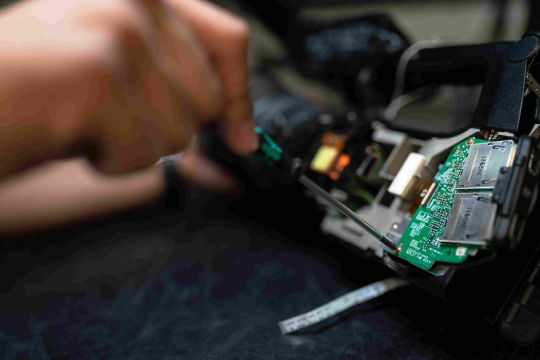
What is Virtual Reality?
Virtual Reality (VR) is a digitally-created environment that allows users to immerse themselves in a three-dimensional world. It uses special headsets equipped with screens, motion sensors, and audio to transport the user to different scenarios – from standing atop the Eiffel Tower to plunging deep into the oceanic abyss.
Imagine one moment you're in your living room and the next, you're floating in space, surrounded by stars and galaxies. That's the magic of VR. It doesn’t just show you a scene; it engulfs you in it.
The Evolution of Virtual Reality
The technology's foundation was first developed in the 1960s in training simulations for driving tanks, flying planes, firing artillery, and other combat-related tasks.
1960s: The Birth of VR Concepts
1962: Morton Heilig, a cinematographer, created the Sensorama, one of the earliest examples of immersive, multi-sensory technology. It was a machine that played 3D films with stereo sound and even emitted scents.
1968: Ivan Sutherland and his student Bob Sproull developed the first head-mounted display (HMD) called the "Sword of Damocles." It was a suspended device, heavy and not user-friendly, but it was groundbreaking.
1970s-1980s: The Dream of Virtual Worlds
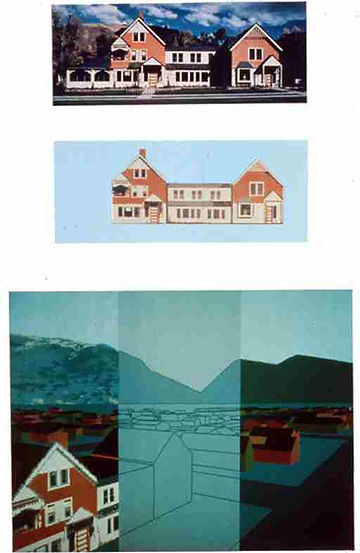
The Aspen Movie Map
1977: The Aspen Movie Map was developed, one of the earliest examples of a virtual tour. Users could virtually walk through the city of Aspen, seeing it in different seasons.
The Aspen Movie Map was made to help soldiers quickly learn about new places. The idea came from a 1976 mission called Operation Entebbe. In that mission, Israeli soldiers practiced on a fake airport before going to the real one. The U.S. Defense Department thought, "What if we could use computers to quickly make a 3D model of a place for practice?"
So, instead of thinking of the Aspen Movie Map just as a video, think of it as an early computer program. This program could take videos, sounds, and pictures and mix them all together. Depending on what the user wanted, the computer would show different things.
1987: The term "Virtual Reality" was popularized by Jaron Lanier, who founded the company VPL Research which developed a range of VR gear including the Dataglove.
1990s: The Rise and Initial Fall
1991: The first VR arcade machines were introduced. Virtuality Group launched a line of multiplayer arcade machines using a HMD and a joystick.
1995: Nintendo released the Virtual Boy, a 3D gaming console that promised virtual reality gaming for the masses. However, due to a combination of high costs and low-quality graphics, it was a commercial failure.
By the late 1990s, the initial hype around VR had died down, mostly due to the technology's limitations and high costs.
2000s: Gaining Ground in Various Sectors
While gaming was the apparent application, the 2000s saw VR used in various sectors from healthcare (for treating PTSD) to automotive design and real estate.

Google Street View
2007: Google introduced Street View, a service that provides panoramic views from positions along many streets in the world, a form of virtual reality that’s used by millions.
2010s: The Modern Era of VR
2010: Palmer Luckey designed the first prototype of the Oculus Rift. This prototype, built on a garage but refined with the help of a Kickstarter campaign, would set off the new wave of VR.
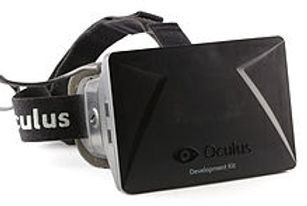
Oculus Rift
Oculus Rift is a discontinued line of virtual reality headsets developed and manufactured by Oculus VR.
It was the first virtual reality headset to provide a realistic experience at an accessible price, utilizing novel technology to increase quality and reduce cost by orders of magnitude compared to earlier systems.
2016: The release of consumer-friendly VR systems like the HTC Vive and the Oculus Rift made high-quality virtual experiences available to the general public.
2018: Standalone VR systems like the Oculus Quest removed the need for external computers or sensors, pushing VR technology further into the mainstream.
A standalone VR is a monolithic headset, with a built-in screen processor and battery, as well as several viewfinders on its body that provide stable spatial orientation and position recognition relative to the world coordinates of additional peripheral devices.
2020s and Beyond
VR technology has continued to improve with better graphics, more intuitive controls, and lower prices.
As we move further into the 2020s, VR is finding applications beyond gaming, in education, collaborative workspaces, social interactions, and more, showing that the evolution of VR is ongoing and its potential limitless.
Conclusion
The world of Virtual Reality has come a long way from its humble beginnings. Today, it's not just a tool for entertainment but a powerful instrument capable of changing how we learn, work, and interact. As technology continues to evolve, the possibilities with VR are endless.
0 notes
Text
Metaverse VR And The Future Of Entertainment
The Metaverse VR industry is currently experiencing a period of rapid growth and development. This digital realm allows users to interact, communicate, and conduct business in a fully immersive and interactive environment. In recent years, the Metaverse virtual reality industry has been driven by technological advances and the increasing adoption of virtual reality by businesses and consumers.

Image Souce
As devices become cheaper and more functional, we expect this adoption to continue. This increased availability is likely to have huge effects on our current understanding of entertainment, gaming, education, and training.
Trends in the Metaverse virtual reality industry include the development of the Metaverse as a service and the increasing integration of virtual reality into everyday life. The current state of the Metaverse virtual reality industry is one of excitement and potential, with advancements in virtual reality technology and increasing adoption by businesses and consumers.
The Rise Of The Metaverse VR Industry
While the idea of virtual reality dates back decades, it was in the late 20th century that technological advancements allowed it to really take off. Here is a brief timeline of key events and milestones in the development of virtual reality and the Metaverse:
1957: Morton Heilig, a cinematographer and inventor created the first VR-like experience called the Sensorama. It was a machine that could simulate a full sensory experience, including sight, sound, smell, and touch. It was developed to be used with short films to make people feel like they were in the film.
1960s: Ivan Sutherland, a computer scientist and engineer developed the first VR headset called the Sword of Damocles. It was a head-mounted display with a wide field of view and was connected to a computer that generated 3D graphics. The headset was heavy and required a user to be suspended from the ceiling to use it, hence the name "Sword of Damocles."
1980s: Jaron Lanier and Tom Zimmerman formed VPL Research, one of the earliest VR product firms. They developed a range of VR products, including the Dataglove, a glove that could interact with virtual objects, and the EyePhone, a head-mounted display with stereo sound and 3D graphics. VPL Research was instrumental in bringing VR technology to the mainstream and establishing it as a viable industry.
1990s: VR technology becomes more widespread with the release of VR headsets such as the Virtuality VR system and the Nintendo Virtual Boy.
2010s: VR technology becomes more advanced with the release of high-end VR headsets such as the Oculus Rift and the HTC Vive.
2020s: The Metaverse has become a major focus in the virtual reality industry, with the emergence of virtual reality-based social platforms and marketplaces such as VRChat and Decentraland.
The Metaverse virtual reality industry is growing and developing, with the worldwide virtual reality market expected to reach $44.09 billion by 2025. Major players in the industry include Oculus, HTC, Facebook, Decentraland, and VRChat, as well as a growing community of developers and users exploring the Metaverse for a growing number of purposes.
Exploring the Opportunities in Metaverse Entertainment
To participate in Metaverse virtual entertainment as a creator or consumer, hardware requirements such as VR headsets and powerful computers may be necessary. These can be barriers to entry for some users, but there are also options for accessing the Metaverse through mobile devices or browser-based VR experiences.
Specific examples of Metaverse virtual entertainment include games like "Rec Room," live events like virtual concerts, social spaces like VRChat, and interactive art installations like "Dreams of Dali" on the Decentraland platform. These experiences showcase the diversity and creativity within the Metaverse community and hint at the potential for the future of VR entertainment. The increasing accessibility and affordability of VR technology may make it easier for more creators to enter the market and share their ideas with a wider audience.
Wrapping Up
The Metaverse industry is poised for significant growth in the coming years, with a wide range of entertainment experiences being explored and developed. From games and live events to social spaces and interactive art installations, the Metaverse virtual reality offers a vast array of ways for creators and consumers to engage with this exciting new medium.
Bluemoon Metaverse's Metaverse as a Service approach will boost virtual reality's development. Bluemoon Metaverse has positioned itself as a leader in the Metaverse VR business by delivering a variety of virtual reality entertainment venues and promoting community-driven development. The Metaverse as a Service approach may boost virtual reality development and innovation.
To learn more about Metaverse virtual reality and the future of entertainment, we encourage you to join our Discord community, follow us on Twitter, LinkedIn, and Instagram, and stay up-to-date on all the latest developments in this exciting field. And remember to join the waitlist to win a share of our $55,000 giveaway! So, please don't wait and join us to participate in the Metaverse virtual reality revolution!
0 notes
Text
• Nikki Doyle - Wild Thing # 1 • ( Comic )
These starters have been taken from the ' Nikki Doyle - Wild Thing ‘ comic !
As always: Feel free to change anything within these starters that you see fit to make it work for your muse & the receiver’s muse !
Recommended For: villain / antihero / crimefighting / techsavvy - muses/plots/timelines.
** Any slight wording changes / sentence break ups made to the original text is to accommodate for RP purposes or more clarity. **
Trigger Warning For: Swearing, Innuendo, Addiction, Murder & Violence
“ I can’t believe it ... they threw everything at you -- and you just swatted them aside.
“ I got ‘em ... everyone ... They said it couldn’t be done ! They said no one could get this far -- but, I did it ! “
“ ( Name ), Y’bonehead, what are ya doin’ jus’ standin’ there ? Unplug ‘im before he fritzes the unit ! “
“ Reckon we’re too late ... “
“ ( Name ), get rid of the barbecued stiff an’ run a check on the unit. “
“ What would happen to my reputation for discretion if I didn’t make sure ? “
“ Six months ago -- she was one of the worst cases of virtual reality addiction I’d ever seen ... an’ I’ve seen plenty ! “
“ For some of them -- it became more than a game. It became their life ! “
“ After trying all the programs they could buy legally, They’d go after the Black Market programs, the illegal stuff -- A whole new crime culture grew up around supplying these electronic addicts. “
“ New programs were hitting the streets. These programs do something to the brains of the user. They make the programs more real, more intense ... these babies kill ! “
“ After six months without it, she’s probably screaming for somma that action herself. “
“ What is this, ( Name ) ? Don’t you trust me ? “
“ You useta be easy to trust, ‘cause I knew you only wanted one thing -- to play my games. “
“ You’da sold your own mother to get enough to play. You were a real sweetie ... “
“ Problem was - you still didn’t have enough. “
“ Pick a switch, any switch ... so long as it’s the right switch ! “
“ Gatecrashers to party pooper, looks like a full house. “
“ You heard the man ... Let’s Go ! “
“ Let’s hustle, boy ... time’s a’wasting ! “
“ Lock and load, guys ! We’re not welcome in this neighborhood so stay alert ! “
“ Everything I build, I build to last. “
“ The building’s secure. ( Name ) took care of the only two ‘ tough guys ‘ in the place. “
“ NO ! You don’t just shut down machines like these until you know what kind of programs they’re running ! “
“ If they’re running one of the illegal programs, you may as well just shut down the user’s brain ! “
“ These programs modify the brain patterns of the user -- that’s how come they’re so intense to play. You have to ease things back to normal in the program & in the player’s head ! “
“ ( Name ), don’t you ever make me do that again ! “
“ You’re still hyped up from all this excitement. I’ll bet you feel bad about ratting your old buddies out ... but don’t kid yourself -- you will be doing this agin. It’s part of our agreement. “
“ I gave you back your life, ( Name ). Don’t you ever forget that ! “
“ The headset will give you environmental data and rangefinding and the dataglove controls the weapons system. “
“ The program’s logic curve has warped so far I can barely keep track of it. “
“ ( Name ), respond ! The program’s logic curve has flattened out, but you should expect another warp ! “
“ He’s not in the immediate vicinity, but there’s a lot of static which is fogging the scanner. “
“ ( Name ) used to play games more dangerous than this -- but they survived. “
“ That may mean they can survive the warp ! “
“ Let go of me, you ugly -- !! “
“ I don’t remember him doing that in the comics. “
“ They are very well armed, ( Name ) ... “
3 notes
·
View notes
Text
Introdução à Realidade Virtual:
Realidade Virtual é a tecnologia que, através de fones de ouvidos e óculos estereoscópicos, geram imagens e sons realistas que simulam a presença de um usuário em um ambiente virtual. Essa interação é realizada em tempo real, com o uso de técnicas e de equipamentos computacionais que ajudem na ampliação do sentimento de presença do usuário no ambiente virtual.
Realidade Imersiva:
A realidade imersiva consiste na sensação de inclusão do utilizador de um ambiente virtual, ou seja, o utilizador sente-se dentro do ambiente e a interagir com os seus elementos. Para produzir no utilizador esta sensação, o sistema tem de conseguir estimulá-lo sensorialmente, utilizando diversos dispositivos, como o capacete de visualização (head-mounted display), as luvas de dados (datagloves) e os auscultadores (headphones) é também importante considerar outros aspetos na imersão, como o lugar utilizado, a forma como é efetuada a projeção, a posição e as deslocações do utilizador, a distância do utilizador aos controlos e a qualidade do som.
Realidade não imersiva:
A realidade não imersiva ao contrário da realidade imersiva, consiste na sensação de não-inclusão experimentada pelo utilizador de um ambiente virtual, ou seja, neste caso o utilizador não se sente como parte do ambiente. É considerado ambiente não imersivo a visualização de imagens tridimensionais através de um monitor e em que o utilizador interage com os elementos do ambiente virtual através de dispositivos como o rato, o teclado e o joystick.
1 note
·
View note
Text
Technology Breakthroughs 2019
what is technology:
technology is the knowledge of techniques and processes mixed with skills and methods that enables human to apply this knowledge, technology had started by the pre-historic man when he used a very simple tools to secure his living from food and protection, then technology uses evolved from just a surviving tool to become the backbone of living that interfered in every single detail of human daily life, from the Toothpick to the space-traveling that is like a dream coming true as their rich tourists had made a space trip and its expected that it will be common and affordable trip in the upcoming years, so let’s talk about the most exciting technology breakthroughs in 2019.
Top Breakthroughs
5G Technology:
2019 is going to witness the releasing of the fifth generation of cellular mobile communication (5G) that featured with reduced latency, energy saving, cost reduction, higher system capacity, and massive device connectivity, and it’s the natural evolution of the 4G Technology that had been released on 2009 in Sweden and that was a great breakthrough in the history of mobile internet that the internet speed could reach 100 megabytes per second for high mobility mobile communication, so let’s get back to 5G technology that its speed is expected to reach 2500 MB (Megabyte) per second as peck performance, 5G mobile devices had seen a great improvement in technicality as it depend on a cell communicate by radio waves with a local antenna array and automated transceiver in the cell with low power consumption rate the antenna is connected with the telephone network through optical fiber cables or wireless backhaul connection, the devices that will equip the 5G technology is going to have 4G LTE capability as the 5G access is not available everywhere till now, the 5G is going to be used in the autonomous vehicles to support it with data about the surrounding environment in real time and nearby vehicles that could exchange their locations and intentions, the roadway is also able to deliver traffic conditions immediately ahead, which will ease the task of driving, also 5G technology is going to be compatible for laptops computers to enhance its Internet communication.
Virtual Reality (VR):
Virtual reality (VR) technology had started in the early 1950th as Morton Heling wrote about the “theater experience”, and built a prototype of Sensorama vision dubbed in 1962, this device displays engaged multiple scenes, then he developed the “Telesphere Mask”, the year 1968 had seen the releasing of the first head mounting display (HMD) system for simulation applications by Douglas Engelbart and other scientists, the 70th had seen a great leap in the virtual reality technology by interfering in many fields like medical, military and even space science as David Em was the first one to produce navigable virtual worlds in NASA laboratory, in 1979 Eric Howlett developed the Extra Perspective (LEEP) optical system which make the virtual reality helmets available today, 1991 had seen the invention of the first cubic impressive room allowing people to see their own bodies in relation to each other’s in the room, between the years 1982 and 1992 Nicole Stenger created the first real time interactive impressive movie that viewed by using a dataglove and a high resolution googles, then the new millennium comes with new update in VR technology, by the year 2001 the first pc based on cubic room had been invented, in the year 2007 google had released the street panoramic view by using 3D stereoscopic mode, 2013 had seen the start of using the virtual reality technology in smart phones by using a headset that used in virtual and augmentation of reality, the Oculus VR project had seen the light Valve Corporation, in the year 2014 Facebook had bought the Oculus VR for 2 Million dollar, and also Sony had announced the launch of the PlayStation VR project, In the year 2015 Google had announced the launch of cardboard a do-it-yourself stereoscopic viewer for smartphones, 2016 had seen a great leap in the VR technology development by many companies specially HTC which had shipped the Vive Steam VR headset as the major commercial release in this year, Sony had continued the development of the wireless headset and evolved it and released the Vive for PlayStation VR. 2019 is going to see a great leap in VR technology as Sony is working to release 3D Rubber Motion Controller for PlayStation VR, SOMNIACS company is working on Somniacs Birdly VR Flying Simulator, but this will not be the last update in the VR technology.
Artificial intelligence (AI) technology
Artificial intelligence concept had started to be known from the year 1940 by the invention of the programmable digital computer, the machine based on the abstract essence of mathematical reasoning, Dartmouth college had founded the AI research field in the year 1956, by the year 1973 the artificial inelegance had faced a new challenge from the USA and the British governments as they stopped the funding undirected research into artificial intelligence, the investors started to take the role of the governments in the funding this research but by the 80th they started to withdraw from this business because of the absence of the needed computer power (hardware), but this all had changed by the beginning of the 21 century as that the machine learning was successfully solved a lot of academic and industrial problems, the AI development in the new millennium started with the creation of the interactive toys (smart toys) in the year 2000, in the year 2004 Nasa had navigated the surface of Mars with autonomously robotic exploration rovers, in 2005 Honda released a humanoid robot that is able to walk as fast as humans and he worked as a food servant in restaurant, but the year 2005 had seen a new thinking in the AI technology by the initiation of the blue brain project that aimed to identify the structure of human brain and detect its function in disease and health, between years 2010 and 2014 the humans are being able to communicate and even speak with robots as in 2011 Apple had launched the Siri project and in year 2012 google had launched Google Now, and then the turn comes on Microsoft that released the smartphone apps the uses the natural language to answer the received questions, make recommendations and even perform actions, Artificial Intelligence (AI) Technology is going to see a great leap in 2019 as this year will see the release of:
1- Automated CCTV security cameras:
that featured by:
It could predict potential vulnerabilities, threats and menace.
Tracking missing children.
Tracking theft vehicles.
Quick action.
Identifying criminals and suspected people between the large crowd.
2-general adversarial networks (GANs):
A new concept that will be released in 2019 that will make your AI smarter as an example it could be able to distinguish between the real image or a realistic image that is created by AI technology.
3-Chatbot:
Chatbot that is also known as Smartbot, Talkbot, chatterbot, IM Bot, interactive agent, conventional interface and artificial conversational entity, the Chatbot concept is an artificial intelligence which conducts a conversation via auditory or textual methods, this technology had started in the early 20th century in the year 1960, but in the middle of the century that this technology had turned from simple conversions to powerful promotional tools for media brands and e-commerce businesses, 80% of companies are expected to be using the Chatbot by the year 2020.
3D Printing
3D printing is a number of various computer controlled processes to create a three-dimension object is made by joining and solidifying the material, 3D printing had started to enter the production industry in the early 80th particularly in 1981 when the Japanese scientist Hideo Kodama has invented two methods for fabricating three dimensional plastic models with photo hardening method, the use of 3D printing in production started with functional or aesthetical prototypes then it turned to be additive manufacturing that it can be used in manufacturing a very complex shape or geometry that is pre designed by 3D model or a CAD file, 2019 is going to see a leap in 3D printing specially in the metal 3D printing which depend on digital model that uses layer by layer material build-up approach which gives the metal a full density and high precision, the metal 3D printing technology is going to be used in manufacturing aerospace, oil & gas, automobile and marine applications, 3D printing is going to use new materials and enter the phase of mass production with high technology machines, 3D printing will see new types in 2019 by these types:
Fused Deposition Modelling (FDM): is also known as Fused Filament Fabrication which is the most commonly available and cheapest type of 3D printing.
stereolithographic (SLA): which is known as the world first 3D printing technology as its history returns to the year 1986, stereolithographic printing is Featured by using mirrors but it also had a big disadvantage that it takes too long to trace the cross-section of an object when compared to DLP.
Digital Light Processing (DLP): this type of 3D printing uses a digital light projector to flash one image for each layer at once or images of multiple flashes for larger parts, the output of this type of 3D printing is a digital image composed of square pixels resulting from rectangular blocks called Voxels.
Selective laser sintering (SLS): its creating objects by using Powder Bed Fusion technology and polymer powder, this type of 3D printing is going to be commonly used due to its low price and this type is featured by using a CO2 laser beam in scanning the object surface.
Material Jetting (MJ): this type of 3D printing has the same concept of normal inkjet printers but the difference in this printing type is that it builds multiple layers of ink upon each other until it turns to solid part, Material Jetting featured by offering objects made from multi-material printing and with full-colour.
Drop On Demand (DOD): this type of 3D printing featured by using a pair of ink Jets, one looks like a wax material and the other used for dissolvable support material, DOD printing featured by using a fly-cutter that skims the build area after the creation of each layer to ensure the commencing of this layer, this type of printing is used in casting the lost wax and suitable for other mould making applications.
Sand binder jetting: mainly this type of 3D printing depends on mixing the PMMA powder with binding liquid as an agent to produce parts colors are added to the mixture through another nozzle, binder jetting useful in production of sand cast molds and cores as they are generally made of artificial sand or (silica), this type of 3D printing is featured with its low cost and quite easily integrated into existing manufacturing of foundry process without disruption.
Metal binder jetting: this type of 3D printing is used in the fabrication of metal objects, as the metal powder is bond together using a more poly binding agent, metal binder jetting is featured by producing complex geometries objects beyond conventional manufacturing techniques, this process done on main steps of infiltration process then adding bronze is the object then we go for the sintering process, the output of this printing type had an issue of non-uniform shrinkage that is solved in the design stage.
Direct Metal Laser Sintering (DMLS): this type of 3D printing is like SLS type but the difference in that it is applied on metal objects, laser is used in fusing the metal powder at a point reaching molecular level, DMLS printing process needs a structural support as the output object is Vulnerable to distortion and wrapping due to residual stress.
Electron Beam Melting (EBM): high energy Electron beam is used in the metal fusion; EBM printing is featured with superior building speed upon any other 3D printing types because of its high energy density.
Financial
Blockchain:
Blockchain or blockchain is a growing list of records called blocks using cryptography, blockchains are resistance to modification of the data that was first described in the year 1991 but it was actually created as public transaction ledger of the cryptocurrency (bitcoin) by Satoshi Nakamoto in the year 2008, it is managed by peer to peer network collectivity adhering to a protocol for internal code communication and validating new blocks once recorded, blockchains has many types:
Public blockchains:
Public blockchains have absolutely no access restrictions, its useful as that anyone has a connection to the internet could send transactions as validator, bitcoins and Ethereum are the most known public blockchains Applications.
Private blockchains:
Private blockchains feathered with high privacy as there is no one could join the network until he had been invited by the network administrations, and even the participant and validator access is restricted, this type of blockchains is the most appropriate for companies that are interested in Blockchain technology because of the high control level, its main implement is in accounting and record keeping producer’s business.
Consortium blockchains:
Consortium blockchains are semi-decentralized as its controlling lies between the hands of many companies might control one node in the network and not just a single organization that controls the network.
Blockchains technology will see a great leap in 2019 as these types will rise:
Blockchain will work as a service (BaaS):
BaaS is a cloud-based service that allows customers to build their own Blockchain powered products and it could be including applications, smart contracts, and other Blockchain features without the need to set up or build Blockchain based infrastructure.
Hybrid Blockchain:
Hybrid Blockchain works by providing the best features and functionality of both private and public blockchains, hybrid Blockchain isn’t widely used but it is considered to be the most appropriate for banks.
Federated Blockchain:
Federated Blockchain is the natural evolution of the normal Blockchain, it looks like the private Blockchain but has more customizable outlook, federated blockchains mainly used in financial services.
Ricardian contracts:
Ricardian contracts are the start of the dependence on legal contracts that cryptographically signed and verified, Ricardian contracts provide unique solutions so that they could be understood without mediator or service for both human and computers.
Interoperability between Blockchains:
Interoperability Blockchains aims to improve information across several networks or other Blockchains networks, the cross chain services improve the daily use of Blockchains, 2019 will see an improvement in the interoperability Blockchains technology, the main applications for Interoperability Blockchains are BlockNet, Aion, WanChain, and others.
Stable Coins:
Stable coins are the side product of the cryptocurrencies, that is affected by the market condition and the stability maintained in all time, most of the stable coins are fiat-chained but they are also backed by commodity stable coins, the main applications for stable coins are everyday currency transaction and P2P payments.
Security Tokens:
Security tokens had replaced the ICOs because it is more secure and protects the investor’s rights redefines the whole investment process, by the current year 2019 investors will tend to use security tokens (STO) than (ICO).
Financial Relegation:
Financial relegation is a type of relegation or supervision, which targets financial institutions with certain requirements, guidelines and restrictions that aims to maintain integrity of the financial system, this system could be handled by government or non-government organization, financial relegation had initiated by the Dutch authorities in the early modern period on the year 1610 as short selling which means that the buyer doesn’t own the asset but he borrows it from the seller and returns it back after short time with profit, then the Financial relegation took its development way until it took the form of banks in our days, the 2010 financial crisis had affected the relegation in a positive way as regulators put a fourth substantial number of new strengthened regulations and expanded requirements, 2018 had seen a great focus on legislative agenda towards protecting the consumers and investors and encouraging financial technology innovation, 2019 is going to see big leap in the financial relegation field as Asian investors will continue their 2018 financial vision to make the trajectory of embedding global post-crisis reforms, and make the Asia-pacific outlook the trends navigating guide across the region, in Europe 2019 is expected to be the year of continuity of regulatory terms, As the first half of the year will be finalizing the legislative initiatives to complete the banking Union, strengthen the EMU, and Capital markets Union.
largest technology construction projects in 2019
London Crossrail:
London Crossrail is the world first continues growing underground system that it extends the railway system with 73 miles (117 kilometers) that links between Berkshire and Buckinghamshire this line holds the name of Elizabeth Line that will be divided into two lines, this huge project expected to cost 23 million Pound, London Crossrail had the approval to start to work on it on 2008 and it’s excepted to launch in autumn 2019.
Benban Solar Park:
Benban solar park will be the world largest photovoltaic power station than expected to generate 1650 (MVP), its located in Upper Egypt particularly in Aswan, the Benban solar park is part of Egypt’s Nubian sun project that aims to be part of generating 20% renewable power of total Egyptian needed power, this Egyptian national project is expected to start working by the end of 2019.
1 note
·
View note
Text
PROvision 100 VR Turnkey System
New Post - PROvision 100 VR Turnkey System -
Headset: PROvision 100 VR Turnkey System
Manufacturer: Division Ltd, UK
Platform: Custom Intel i860, INMOS Transputer
Graphics: 35,000 Gouraud-Shaded, Z-Buffered Polygons
Cost: $50,000-$200,000
Launch Date: 1992
Estimated Value: $7,000+
Other Features: VPL DataGlove, Stereo HMD, Stereo Audio, C-language Toolkit (dVS)
The next step in VR integration was to shrink each of these components and put…

View On WordPress
0 notes
Quote
On my hands, I wore a pair of state-of-the-art Okagami IdleHands haptic datagloves. Special tactile feedback pads covered both palms, allowing the gloves to create the illusion that I was touching objects and surfaces that didn't actually exist.
Ernest Cline, Ready Player One
15 notes
·
View notes
Text
Virtual reality is the rich white child of technology
Virtual reality is the rich white child of technology
https://theministerofcapitalism.com/blog/virtual-reality-is-the-rich-white-child-of-technology/

Has been seven years since Palmer Luckey appeared on the cover of WIRED magazine. The June 2014 issue stated: “This guy is about to change games, movies, television, music, design, medicine, sex, sports, art, travel, social media, education and reality “. In 2016, Facebook acquired its virtual reality company, Oculus, for $ 2 billion. It now invests $ 18.5 billion annually in research and development, and Facebook Reality Labs, the company’s augmented reality / virtual reality division, accounts for up to 20 percent of its entire workforce, with no sign of deceleration. But despite the many years, billions of dollars and the one-year pandemic requiring home entertainment, the results so far have been pretty poor. Headphones are more attractive and games are more lucrative, but our minds are still held together. without blowing.
It’s not just Facebook and Oculus. In May 2016, WIRED cover story presented to readers Magic Leap, “A mysterious startup, a mountain of money and the quest to create a new kind of reality.” Magic Leap was developing a set of semi-transparent “mixed reality” glasses that could integrate virtual objects into the user’s physical environment. The company raised more than $ 2 billion in financing from Silicon Valley List A investors. It seemed like the biggest leap in hardware since the iPhone. But the the actual product never lived up to the impressive demonstration. The company laid off 1,000 employees in 2020, it hired a new CEO and focused on smaller business applications. The future of mixed reality is still, well, the future.
Somehow, none of these less-than-ideal outcomes has affected confidence in virtual reality. In fact, Facebook doubled down on Monday, announcing a new group within the company dedicated to the development of its world Horizons VR. Mark Zuckerberg he recently told Facebook employees which over the next five years hopes to move “from people who see us as primarily a social media company to being a metaverse company”. It seems that Silicon Valley billionaires and venture capitalists are unable to say no to luxury headphones with a big dream. And that goes back 35 years: Jaron Lanier was the Palmer Luckey of the eighties and early nineties.
Technology always is About turn a corner, About be more than just a gaming device, About revolutionize fields such as architecture, defense and medicine. The future of work, entertainment, travel and society is always on the brink of a huge virtual update. Virtual reality is a bit like a rich white guy with famous parents: he keeps crashing upwards, ranked forever in a generous curve, always judged based on his “potential” rather than his results.
One of the reasons VR has been offered a myriad of second chances (the proverbial lineage of VR, if you will) is that it has played an oversized role in popular science fiction on which our collective image of the future is based. William Gibson coined the term “cyberspace” in his 1984 book Neuromantic. The term later became synonymous with the World Wide Web, but Gibson’s initial interpretation was of a virtual realm that “console cowboys” could enter and exit. Gibson and his cyberpunk colleagues shaped the technology culture of the 1980s, before the dotcom boom, before the tech boom.
When Lanier unveiled his huge head-mounted screen and dataglove in 1987, he was inviting tech enthusiasts to be the first inhabitants of the virtual future they had glimpsed in cyberpunk novels. 1992 by Neal Stephenson Snow Crash and in 2011 by Ernest Cline Ready Player One later, there were great science fiction successes whose stories unfolded in a future where virtual reality is an accessory.
When Zuckerberg he says who has been “thinking about some of these things ever since [he] I was in high school and was just starting to code, “it’s not hard to guess which books I was reading at the time. For Gen X and Millennial tech entrepreneurs which dominate Silicon Valley today, the science fiction stories of his youth have always treated virtual reality as an environmental part of the future technological landscape.
Like the current billionaire space race it is, at least in part, evidence that within every technology billionaire there is an inner child who dreamed of flying his own rocket, the VR arms race is based on the assumption that mass adoption is inevitable; the only question is when will this future come, and what company will get rich when it does.
Source link
0 notes
Text
How did the history of AR and VR begin, and how do these technologies differ from one another?
“In virtual reality, a person is completely immersed in the virtual world and does not interact with the real world. Everything he sees is simulated by a computer. Unlike virtual reality, augmented reality augments the real world with virtual objects rather than replaces it entirely.”
“The term ‘virtual reality’ was coined by the scientist Jaron Lanier in 1987. The first mention of this technology among science fiction writers is found in Stanley Weinbaum’s short story Pygmalion’s Spectacles, published in 1935. In this story, Professor Ludwig invents a device that helps Dan Berk, the protagonist, dive into virtual reality. The term ‘augmented reality’ was first suggested by Tom Codell in 1990. In science fiction, the first mention of this technology might be in the novel The Master Key written in 1901. In the novel, Frank Baum described a device that can mark people with letters and show their character in real time.”
Where did it all begin?
The first device associated with VR is the the stereoscope created by Charles Wheatstone.

“A stereoscope is an optical system in which the left and right eye see different pictures. There are two pictures, or stereo cards, which show the same scene, but from a different angle, simulating the difference between how the right and the left eye would percept it. Thus, the scene seems three-dimensional.”
Above Image: The Sensorama, the first virtaul simulator was developed by an American filmmaker and inventor Morgan Heilig in 1957. This mechanical device included a stereoscopic 3D display, a motional chair, fans to imitate wind, etc. But this machine was too expensive and was not mass-produced.

Above Figure: The Sensorama, the first virtaul simulator was developed by an American filmmaker and inventor Morgan Heilig in 1957. This mechanical device included a stereoscopic 3D display, a motional chair, fans to imitate wind, etc. But this machine was too expensive and was not mass-produced.
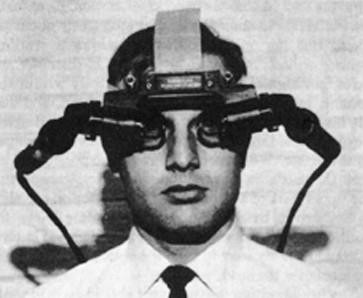
Above Figure: The first VR-AR helmet was developed by Ivan Sutherland, a Harvard Professor and his student Bob Sproull in 1968. It was named “ The Sword of Damocles” and was a bulky device attached to the ceiling.
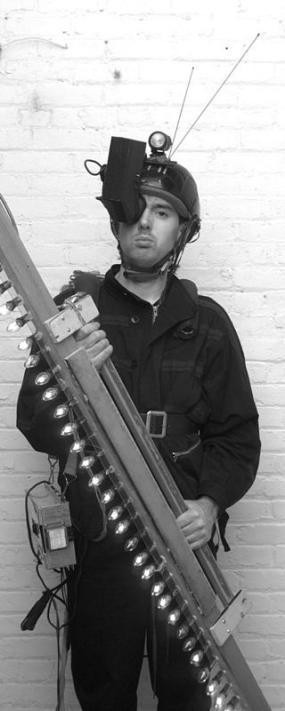
Above Image: EyeTap was the first portable AR device created in 1980. This device had a computer that was in the backpack and superimposed a picture onto the real world.
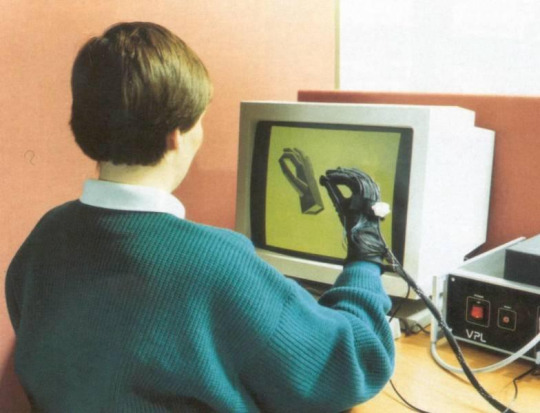
Above Image: Jaron Lanier created EyePhone glasses and a DataGlove in 1987. He was also the one to coin the term ‘virtual reality’.
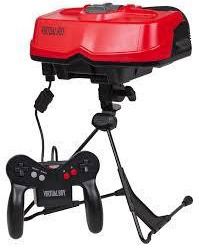
Above Image: Virtual Boy Nintendo was released in 1995 and was sold in Japan and North America for $180.
To conclude,
VR and AR haven’t been recent discoveries as their history began in the past century and continues to evolve even today.
https://arvrjourney.com/the-history-of-ar-and-vr-3faea3f1e94b
0 notes
Text
A Brief Introduction to Immersive Systems: History of VR (part 2)
In 1980, StereoGraphics company creates stereo vision glasses. (image source)

In 1982, Thomas G. Zimmerman files a patent (US Patent 4542291) on an optical flex sensor mounted in a glove to measure finger bending. He works with Jaron Lanier to incorporate ultrasonic and magnetic hand position tracking technology to create the Power Glove and Data Glove, respectively (US Patent 4988981, filed 1989). Together they found VPL Research, Inc. This company is known as the first company to sell VR goggles and gloves. They develop a range of VR equipment, such as, the DataGlove, EyePhone HMD and the Audio Sphere. The optical flex sensor used in the Data Glove is invented by Young L. Harvill who scratches the fiber near the finger joint to make it locally sensitive to bending.

“In this photograph from June 7 1989, two people demonstrate the EyePhone system, which uses special goggles and a DataGlove, which allows them to see and move objects around in a computer created environment. The EyePhone, developed by VPL Research.”

Nintendo’s Power Glove (1989).

VR testing at VPL Research.
In 1986, Thomas A. Furness develops a flight simulator between 1986 –1989, known as the Super Cockpit. The training cockpit features: computer-generated 3D maps, advanced infrared and radar imagery and the pilot can see and hear in real-time. The helmet's tracking system and sensors allow the pilot to control the aircraft using gestures, speech and eye movements.
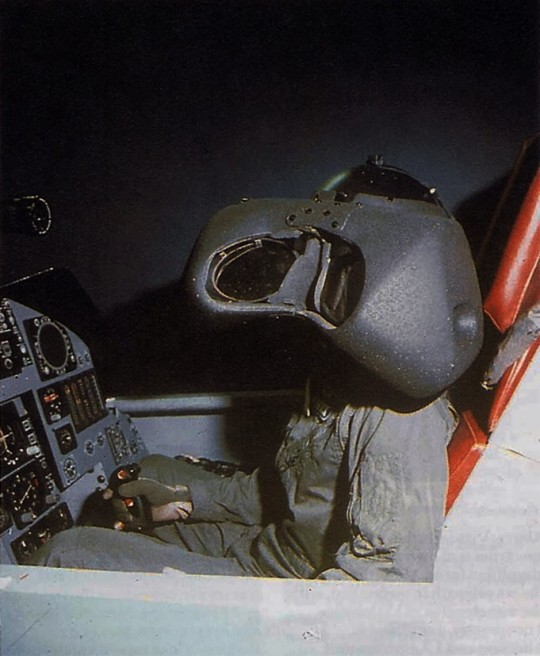

In 1987, British Aerospace uses the HMD similarly to Furness' Super Cockpit and develops the Virtual Cockpit (couldn’t find source) which also features speech recognition.
In 1989, Scott Foster founds Crystal River Engineering Inc after receiving a contract from NASA to develop the audio element of the Virtual Environment Workstation Project (VIEW) - a VR training simulator for astronauts. Through this company real-time binaural 3D audio processing is developed. The photograph below is one of my favourite.

In 1990, Jonathan Waldern exhibits Virtuality, a VR arcade machine, where gamers can play in a 3D gaming world, at the Computer Graphics 90 exhibition in London. This is the first mass-produced VR entertainment system. A Virtuality pod features VR headsets and real-time immersive stereoscopic 3D images. Some of the machines can be networked together for multi-player games. Eventually some of the very popular arcade games, like Pac-Man, have VR versions.
In 1991, Antonio Medina, a NASA scientist, designs a VR system to drive the Mars robot rovers from Earth in supposed real-time despite signal delays between the planets. This system is called "Computer Simulated Teleoperation".
Also in 1991, SEGA announces that they are working on the SEGA VR headset which would be available for the general public to purchase. They hire design house IDEO (who would go on to design the Viewmaster VR) to create a design This headset is meant to be used for arcade games and the Mega Drive console. It has a visor-like look due to the influence of popular films, such as, RoboCop. LCD displays are placed in the visor, as well as stereo headphones and sensors for tracking head movement. However, it is never released even though four games are made for it. One of the explanations for the termination was SEGA's concern of people injuring themselves as the VR effect is too realistic. However, this seems unlikely due to the limited processing power.

In 1994, SEGA releases SEGA VR-1, a motion simulator arcade machine.
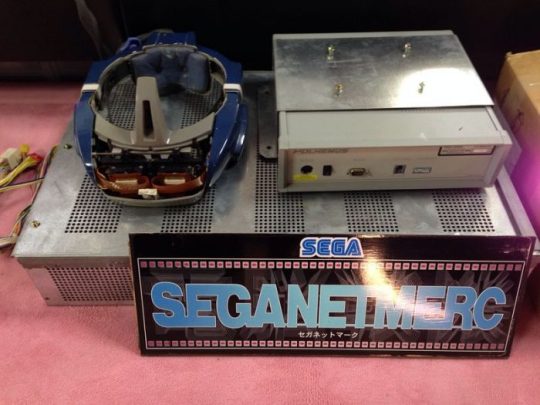
Also in 1994, VictorMaxx (couldn’t find source) releases a VR headset called VictorMaxx StuntMaster.

In 1995, Nintendo launches the Virtual Boy console which plays 3D monochrome video games. It is the first portable console to display 3D graphics. But it is a commercial failure due to: the lack of colour graphics, lack of software support and it isn't comfortable to use. One year later it is discontinued.

Affordable home VR headsets are released: 1. Virtual IO (couldn’t find source) releases the I-Glasses. 2. VFX1 Headgear is released by Forte Technologies, Incorporated (couldn’t find source).
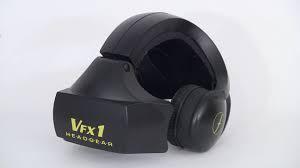
The VFX1 Headgear.
In 1998, Georgia Tech and Emory University researchers use VR to create war zone scenarios for veterans receiving exposure therapy for PTSD. This is known as Virtual Vietnam.
Sources:
Barnard, Dom. "History of VR - Timeline of Events and Tech Development." Virtualspeech. August 06, 2019. https://virtualspeech.com/blog/history-of-vr.
Bibby, Joe, Ryan Necessary. “Robonaut 1.” National Aeronautics And Space Administration. https://robonaut.jsc.nasa.gov/R1/sub/simulation.asp.
Bye, Kent. “50 Years in VR: Tom Furness’ Journey from Making More Lethal Pilots to Non-profit Learning (Voices of VR Podcast – Episode #245).” Roadtovr. November 17, 2015. https://www.roadtovr.com/50-years-vr-tom-furness-super-cockpit-virtual-retinal-display-hit-lab-virtual-world-society/.
Furness, Thomas A. “The Super Cockpit and Its Human Factors Challenges.” Proceedings of the Human Factors Society Annual Meeting 30, no. 1 (September 1986): 48–52. https://journals.sagepub.com/doi/abs/10.1177/154193128603000112?journalCode=prob#articleCitationDownloadContainer.
Google Arts & Culture. “Virtual i-O i-glasses! Personal 3D Viewer head-mounted display.” Deutsches Museum, 1995. https://artsandculture.google.com/asset/virtual-i-o-i-glasses-personal-3d-viewer-head-mounted-display/4wHrXHZrWs9ZBA.
Gotz, David. “Virtual Vietnam: Virtual Reality Exposure Therapy for PTSD.” David Gotz. 1998. http://gotz.web.unc.edu/research-project/virtual-vietnam-virtual-reality-exposure-therapy-for-ptsd/.
Mindflux. “The VFX1 HEADGEAR Virtual Reality System by Forte Technologies.” 2006. http://www.mindflux.com.au/products/iis/vfx1.html.
Rosson, Lois. “The Virtual Interface Environment Workstation (VIEW), 1990.” National Aeronautics And Space Administration. June 12th, 2014. https://www.nasa.gov/ames/spinoff/new_continent_of_ideas/.
SegaRetro. “StuntMaster.” https://segaretro.org/StuntMaster.
Sorene, Paul. “Jaron Lanier’s EyePhone: Head And Glove Virtual Reality In The 1980s.” Flashbak. November 24, 2014. https://flashbak.com/jaron-laniers-eyephone-head-and-glove-virtual-reality-in-the-1980s-26180/.
Waldern, Jonathan D. “Virtuality Inc.” Virtuality. https://virtuality.com/.
Zimmerman, Thomas G., Jaron Lanier, Chuck Blanchard, Steve Bryson and Young Harvill. “A Hand Gesture Interface Device.” VPL Research, Inc. 1987. http://netzspannung.org/cat/servlet/CatServlet/%24files/228648/DataGlove+CHI+1987.pdf.
#vr#history of vr#virtual reality#history of virtual reality#technology#wearable technology#80s#gaming#wired gloves#wired headsets#hmds#timeline#immersion#immersive systems
0 notes
Text
Tipos de ambientes virtuais
Os ambientes virtuais podem ser de 2 tipos:
Ambiente não imersivo- o utilizador não se sente como parte do ambiente virtual. Exemplos: interação de um utilizador com um teclado/rato.
Ambiente imersivo- o utilizador está “imerso” no ambiente virtual. Este é estimulado sensorialmente com os dispositivos como, por exemplo, luvas de dados, capacete de visualização, entre outros. Uma luva de dados pode ser vista em baixo.
Os ambientes imersivos resultaram do desenvolvimento e da investigação realizados com GUI (Graphical User Interface), ou seja, através de ambientes virtuais e da estimulação dos sentidos do utilizador, vão se obter os tais ambientes imersivos.
Objetos como o capacete de visualização (head-mounted display), as luvas de dados (datagloves) e os auscultadores (headphones) levam com que a visão dos utilizadores deixe de ser o único sentido a ser estimulado, transmitindo ao utilizador a sensação de imersão.

1 note
·
View note
Text
Realidade Virtual
A realidade virtual transporta o utilizador para um ambiente simulado diferente e desliga-o do que o rodeia. Esta é uma experiência imersiva, pois faz o utilizador sentir que está inserido dentro de um ambiente que lhe permite interagir, visualizar e manipular. Para conseguir este tipo de experiência, é preciso que o utilizador use um Head-Mounted Display (HMD), isto é, um ecrã usado na cabeça ao nível dos olhos. O HMD tipicamente tapa a visão das redondezas para ajudar na imersão. Podem também ser utilizados dispositivos tais como o BOOM e o crystal eye, a nível da visão ou como a dataglove, a nível dos movimentos.
0 notes
Text
Realidade Imersiva
★A realidade imersiva consiste na sensação de inclusão experimentada pelo utilizador de um ambiente virtual, ou seja, o utilizador sente-se dentro do ambiente e a interagir com os seus elementos.
★Para produzir no utilizador esta sensação, o sistema tem de conseguir estimulá-lo sensorialmente, utilizando diversos dispositivos, como o capacete de visualização (head-mounted display), as luvas de dados (datagloves) e os auscultadores (headphones).
★Além destes, é importante considerar outros aspetos na imersão, como o lugar utilizado, a forma como é efetuada a projeção, a posição e as deslocações do utilizador, a distância do utilizador aos controlos e a qualidade do som.
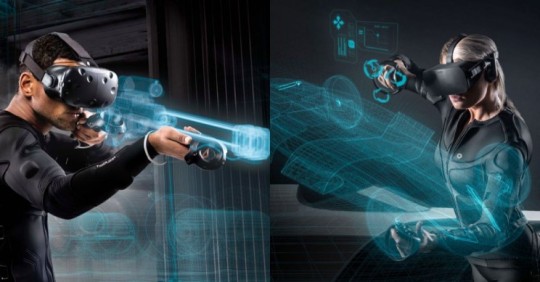
0 notes
Text
Facebook’s plan for our post-web future
Let us connect some dots. Five years ago, Facebook acquired VR pioneers Oculus for $2 billion. This week, it snapped up neural-interface pioneers CTRL-Labs for somewhere north of $500 million, and announced that its own massively multiplayer VR shared universe Horizon will launch early next year.
Oculus became (somewhat creepily named) Facebook Reality Labs, headed by Andrew Bosworth, one of the company’s first 15 engineers, who also headed the company’s transition from desktop to mobile advertising. It doesn’t take much imagination to see that he’s now in charge a much more interesting, and longer-term, transition: from the World Wide Web to whatever lies beyond.
Their big multibillion-dollar bet, the vision floating in Mark Zuckerberg’s crystal ball, is clearly that this new frontier is “cyberspace,” to use William Gibson’s term, or “the Oasis,” to borrow from READY PLAYER ONE, a copy of which was once issued to every new Oculus employee. Virtual reality, in other words, and/or maybe “mixed reality,” which combines our real world with virtual artifacts.
I can see your eyes rolling already. I admit mine are twitching skywards as well. AR/VR, like nuclear fusion and Brazil, have been the future for so long that it’s become a little hard to take that future seriously. Neuromancer was published in 1984. Jaron Lanier demo’d the first real VR headset and motion capture wearable, the EyePhone and DataGlove, more than thirty years ago. No wonder the notion of a shared global VR space increasingly feels like a retro-future.
But to Zuck’s credit, the path to change here is obvious and therefore plausible: use gaming as the bridge. Create the world’s first and best massively multiplayer online VR game. (The theory being it will be more immersive, and therefore more compelling, than Magic Leap’s mixed reality.) Use Facebook’s power, scale, and wealth to bring gamers in until there’s a thriving community of many million monthly users.
Then, transition to the larger vision, of VR slowly supplanting the Web itself; replace laptops with headsets, phones with overlays on smart glasses, and keyboards with neural interfaces. Not all at once, but bit by bit, as the Horizon gameworld gradually, over a period of years, becomes a platform for socializing and messaging and work as well as play. Then the Internet’s denizens won’t just visit Facebook’s web site, or launch its app; instead they will, literally if virtually, live in Facebook’s walled garden.
Is that vision more than a little creepy? You betcha. Is it one that’s likely to come to fruition? Well, no, I wouldn’t say likely. But I’ll concede it has a chance, one sufficiently nonzero, and sufficiently potentially spectacularly lucrative, that Facebook’s ongoing multibillion-dollar bet makes sense. Lucrative in terms of both money and implicit power. Like I said: more than a little creepy.
Of course this isn’t Facebook’s only vision of the future. It’s just one of their bets. Another is to essentially pivot from social-media advertising to messaging and transactions. You have to grudgingly admire their willingness to explore abandoning their current fantastically successful business model in favor of the untried and untested. Anything to disrupt the innovator’s dilemma.
Will this bet pay off? Will Facebook Horizon, plus VR and neural interfaces, be the gateway to “a consensual hallucination experienced daily by billions,” to quote William Gibson? While the odds are against it, it still seems to have a better chance than anything else on our collective horizon.
0 notes